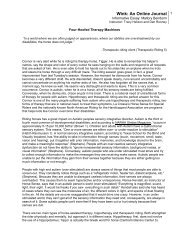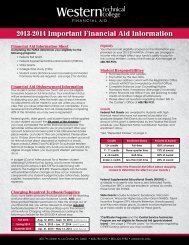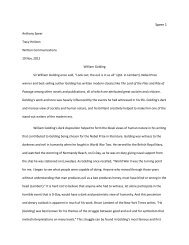The History of Western Technical College
The History of Western Technical College
The History of Western Technical College
Create successful ePaper yourself
Turn your PDF publications into a flip-book with our unique Google optimized e-Paper software.
May 3-6 Miss Portia Winters, a nationally known lecturer and home economist, conducted a four-day cooking<br />
and homemaking school, sponsored by the La Crosse Tribune and the magnificent foods she prepared<br />
before her audiences were given away. In addition, gifts for the home and baskets <strong>of</strong> groceries were<br />
given away at each session.<br />
June 3 “Ladies in Retirement”, written by Regional Denham, was presented by the Winona Players.<br />
October 24 <strong>The</strong> Community Concert Association sponsored the spirited General Plat<strong>of</strong>f Don Cossack chorus in both<br />
sacred as well as folk songs.<br />
Pre-Christmas activities included “<strong>The</strong> Messiah,” presented by the Vocational Civic Choir under the<br />
direction <strong>of</strong> Harold Youngberg. A free will <strong>of</strong>fering was taken for the benefit <strong>of</strong> the Camp McCoy<br />
Hospital Service.<br />
<strong>The</strong> Vocational Civic Orchestra presented the light operetta “Show Boat” and featured seven members<br />
<strong>of</strong> the La Crosse Vocational Civic Choir as vocalists for the popular musical.<br />
<strong>The</strong> war years were grim years, and the community concerts were a morale builder. At several concerts, collections<br />
were taken to benefit the USO (United Service Organizations.)<br />
In 1943, directing the activities <strong>of</strong> the La Crosse Vocational and Adult Schools were A. P. Funk, president; J. G. Becker, vice<br />
president; Raymond C. Bice, secretary; Frank A. Papenfuss, and Dr. R. W. Bardwell, superintendent <strong>of</strong> schools.<br />
In 1943, the school records showed that, although the school still held first place in the world for attendance in<br />
proportion to population, enrollment had gone into a big slump. Evening classes, especially, which formerly drew about<br />
one-fifth <strong>of</strong> the city’s population, became a wartime casualty. Director Coleman attributed the decline to five main<br />
reasons.<br />
1) Many <strong>of</strong> the older students preparing for higher jobs were working a 3 p.m. to midnight shift and could not attend<br />
evening classes;<br />
2) Workers have taxed their energies to keep up the strenuous pace <strong>of</strong> war industries and work overtime;<br />
3) As the war has made everyone more mechanically conscious, those who took mechanical courses to develop a second<br />
skill were already established in war jobs;<br />
4) Because <strong>of</strong> the dire need to employ workers, companies were training them while they learned; and<br />
5) Women who took part in avocational programs were spending their time rolling bandages for the Red Cross, working<br />
in the hospitals as nurse aides or at USO centers.<br />
In the fall semester <strong>of</strong> 1943, Evening School enrollment was down to 1,034 and was attributed to “right now the necessity<br />
<strong>of</strong> training is less than ever because there are jobs everywhere.”<br />
Rehabilitation programs were begun. Under the Selective Service Act, employers across the nation promised the<br />
draftees one thing – a job when they came home. As some <strong>of</strong> the earliest draftees returned home disabled it necessitated<br />
career changes. “Through a planned rehabilitation program, we hope to train young men in crafts and trades that they<br />
are mentally and physically fitted for. We already have trained many <strong>of</strong> these returned war veterans and they are<br />
embarking happily on pr<strong>of</strong>essions they had never dreamed <strong>of</strong> before.”<br />
In 1943, the second wartime year, the Vocational School was a center <strong>of</strong> community service . . . it was the unplanned<br />
coordinator <strong>of</strong> various activities <strong>of</strong> the city . . . it housed the La Crosse Civic Forum . . . it was the practice grounds <strong>of</strong> the<br />
Civic Choir and the La Crosse Symphony Orchestra.<br />
In January 1943, a tremendous boost was given to the development <strong>of</strong> music in La Crosse when the entire musical library<br />
accumulated by the state Works Progress Administration (WPA) was placed in custody <strong>of</strong> the Vocational School. <strong>The</strong><br />
library included 264 titles, and its estimated cost was $5,000.<br />
In 1943, a pair <strong>of</strong> railroad division superintendents and a couple <strong>of</strong> railroad telegraphers made a class in Morse Code<br />
Telegraphy and Railroad Rules so fascinating that more than 40 people enrolled. After completion <strong>of</strong> the course, they<br />
were eligible to begin work on the railroad as extra help, filling in during vacation periods.<br />
In January 1943, the Vocational Board voted that the wives <strong>of</strong> soldiers and <strong>of</strong>ficers stationed at Camp McCoy could attend<br />
either day or evening school without paying the usual nonresident tuition <strong>of</strong> 50 cents a day.<br />
In January 1943, a new training course began for civilian employees <strong>of</strong> Camp McCoy post exchanges. <strong>The</strong> three-week<br />
training program taught students how to make change, check cash, use a cash register, care for and arrange stock, take a<br />
check <strong>of</strong> inventories, arrange stock displays and marking, short order cooking, handling <strong>of</strong>

















